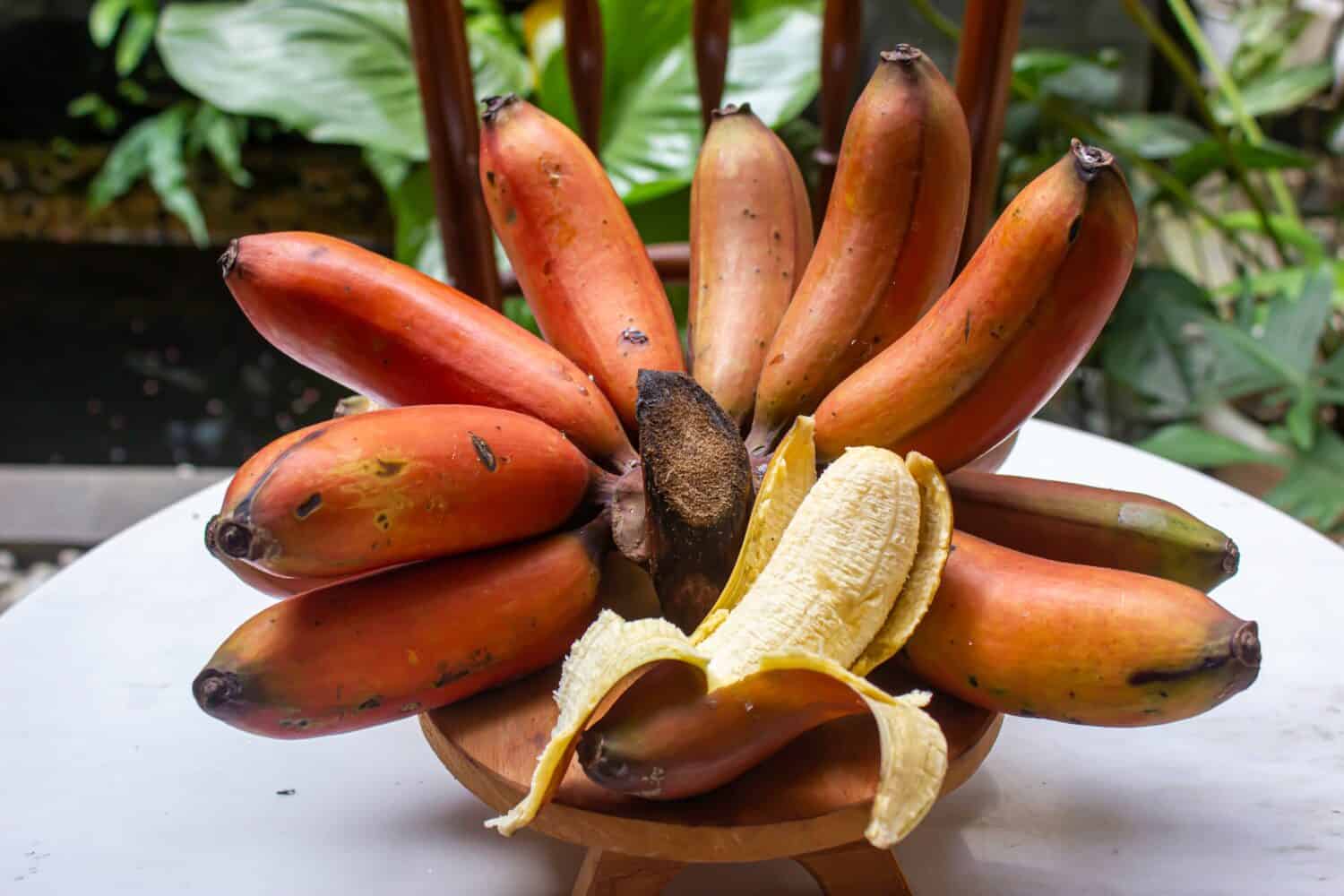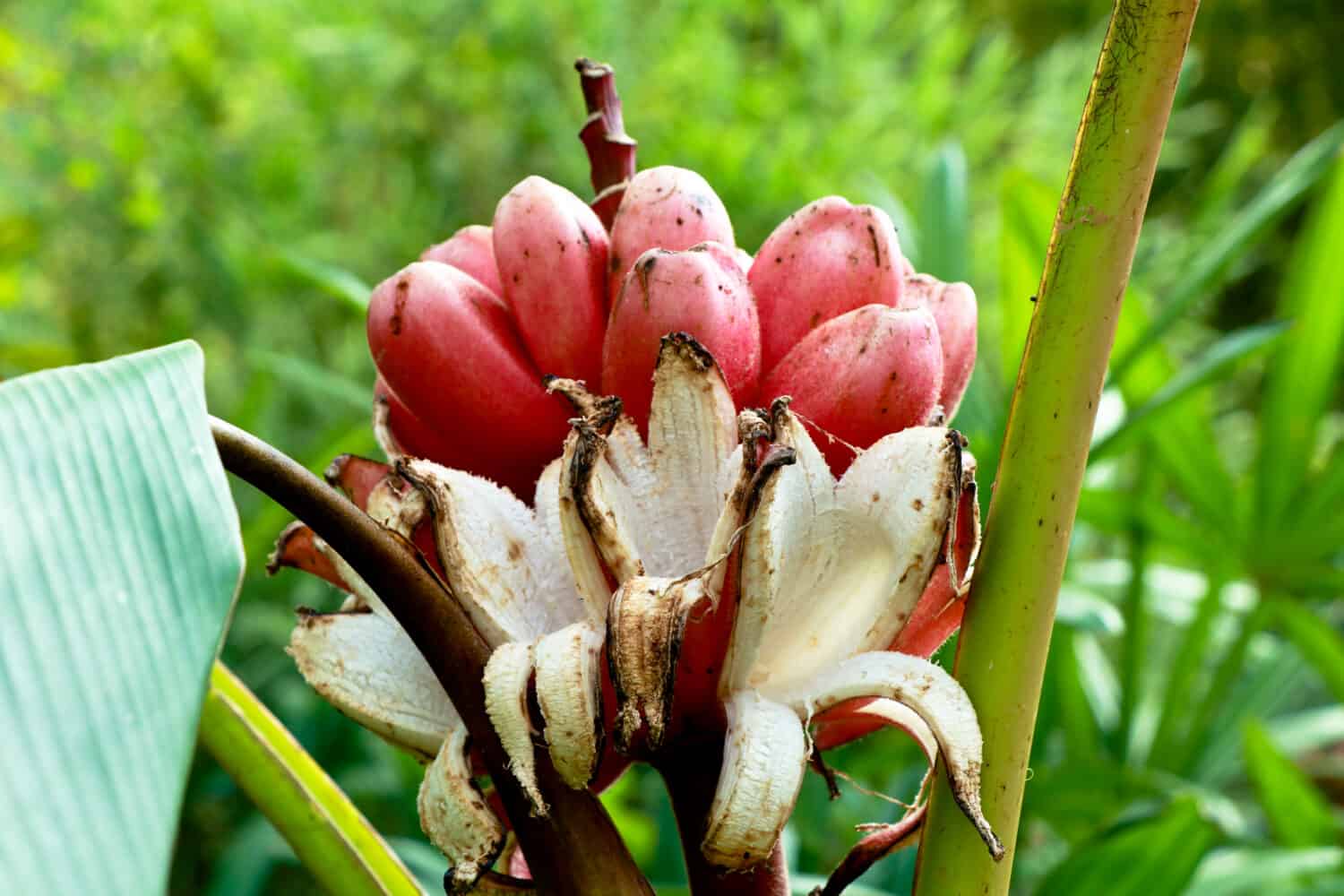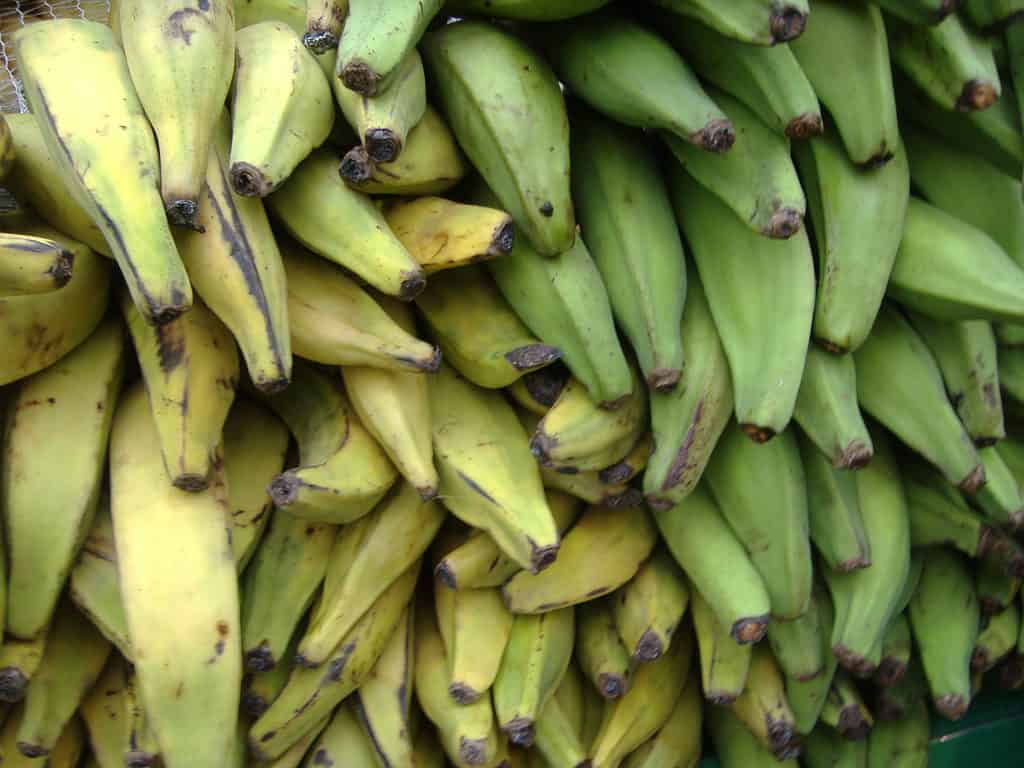We are all used to the standard yellow banana, as it’s the most commonly sold worldwide. However, more than 1,000 different banana varieties are spanned across 150 countries. Each of the banana varieties is divided into 50 groups, which help identify what family they belong to.
Currently, the Cavendish is the most common, but a handful more banana species are out there. One distinctive trait that helps classify these bananas is their color. Each banana species has an amazing color, which can help determine its safety to eat and how rare it is. Below, we’ll go through the six colors of bananas and sort them from rarest to most common.
1. Blue Bananas

Blue-colored bananas are the rarest banana color in the world and often have a wide range of shades ranging from pale to royal blue.
©Cristian Storto/Shutterstock.com
The Blue Java Banana is the world’s rarest banana, notable for its pale blue coloration. When ripe, the Blue Java turns a pale yellow, which is close to your standard banana. However, when growing from the vine, the banana will look blue.
These bananas are often seven to nine inches long and turn a silvery blue when unripe. The fruit has a white creamy flesh and is a delicacy. The Blue Java also has a distinctive feature that resembles human knuckles that are called knuckles.
This type of banana is popular in Southeast Asia. It is a hybrid of two other banana species, the Musa balbisiana and the Musa acuminata. However, the banana also grows in Hawaii, the Philippines, and Central America. No matter where it is grown, it is known as the “Ice Cream Banana” due to its sweet, aromatic smell, custard consistency, and subtle vanilla taste.
Cultures all over the world use the banana as either a decoration or as a food. Cooking the Blue Java ends up with a sweet custard-like delicacy. However, they can also be eaten fresh. As decorations, the plant can be outside as part of the outdoor decor.
2. Red Bananas

A red banana can appear red, orange, brown, and even light pink.
©Yutias/Shutterstock.com
Red bananas are also very rare, with a few different varieties with this coloring. Some produce a bright red, while others may have a reddish-purple hue. Depending on the region, these bananas vary in both size and color. The inside of the fruit is a creamy color or can even turn light pink. These bananas have their signature re-coloring through beta carotene and vitamin C.
When ripe, the bananas will turn a deep red or maroon color. This gives them that signature bright red hue that many people know them for. Depending on the region, these bananas can range in size and taste.
The main known ones are the Red Dacca, Red Spanish, Colorado, Red Cuban, Gluay Nak, and the Lal Kela. They are native to areas in Southeast Asia, East Africa, South America, and the United Arab Emirates but have been cultivated worldwide. Today, they are the most popular type of banana in Central America.
Regarding taste, red bananas have a standard banana taste with a hint of either raspberry or earthy flavor. However, red bananas are often sweeter than yellow Cavendish bananas. Usually, red bananas are eaten as is, but some cultures use them for desserts. Their mild flavor makes them a great addition to fruit salads, smoothies, and baked desserts.
3. Pink Bananas

A vibrant pink color characterizes these bananas, often found in tropical regions.
©JB Frames/Shutterstock.com
Pink bananas (Musa velutina) are ornamental bananas that are also sweet and edible. The banana is often a bright pink color, with some of it becoming more of a reddish tint.
The pink banana is often 3 inches long and has a fuzz covering it. The fruit’s flesh is edible and will naturally split open when they are ripened. The inside flesh ranges from cream to yellow, while the insides range from pink to reddish. Unlike the Cavendish banana or yellow banana, they are shorter and thicker.
Bananas of the pink variety can be found in northeastern India, Myanmar, and Brazil. However, today, they can be found in tropical and subtropical climates. They originated in Assam and the eastern Himalayas but now can be found worldwide.
Mainly, pink bananas are only used as ornamental plants due to having many dense and hard seeds inside of them. The seeds are dangerous if not properly removed and can crack teeth. For that reason, many people avoid using them altogether. However, these bananas are delicious when ripe and have a tangy apple, banana, and raspberry flavor combination.
Since many people don’t eat these, they often use the plant as a yard ornament. In parts of Southeast Asia, they use the leaves as floral arrangements. In other areas, the male buds can be harvested and eaten.
4. Purple Bananas

The purple bananas are a part of the red banana family but have a blueish hue.
©Arif Prabawa/Shutterstock.com
Purple bananas are in the same family as red bananas but have a slightly different hue. Instead of being vibrant pink or bright red, purple bananas have more of a blue tint. Worldwide, they are known as the red banana or Dacca.
These bananas are often found in Southeast Asia, Bangladesh, Burma, and India. The Royal Purple Banana Tree (Musa ornata) is the most notable. The fruits are beautiful and produce a pinkish-purple hue.
Despite the beautiful color, some cultures argue against eating purple bananas. However, the Royal Purple banana is edible. In fact, the tree’s flowers are also edible and taste delicious deep-fried or steamed. Like red bananas, purple bananas have white or pink flesh and a hint of raspberry flavor.
Purple bananas can be used as focal plants in a garden or for medicinal purposes when not used for food. The flowers have healing properties that help with bronchitis, dysentery, and ulcers. On the other hand, the sap of the purple banana tree can be used to treat fevers, diarrhea, and hysteria.
5. Green Bananas

The green coloring of a banana often means that it is unripe.
Green bananas are unripe bananas that turn yellow as they become ripe. Many unripe bananas are In India. These are known as the Kaccha Kela and are used for savory dishes. They are known for having a firm texture and are boiled, steamed, and more.
Other bananas that tend to be green are plantains. Plantains tend to turn yellow as they are ripped and get confused with regular bananas. However, many cultures have found that plantains are good when they are unripe. This produces a very savory flavor that is much different from bananas. Originally, plantains were from Southeast Asia, but they are grown worldwide today.
Plantains and other green bananas are bright green when unpicked and unripe. When the plantain is picked, it will slowly turn into either a greenish hue or a yellow banana. There are many variants of these types of bananas, so they can be a wide range of green hues.
Green bananas are mainly used for cooking, as uncooked, they have a bitter flavor. Some cultures fry and serve them deep-fried, while others turn them into chips. Plantains are often also made into flour in Nigeria and other African countries. The green banana is often used in island and tropical countries such as Central America, the Caribbean, Cuba, and the Dominican Republic.
6. Yellow Bananas

Cavendish, or yellow bananas, are the most commonly known banana worldwide.
©asss sssa/Shutterstock.com
The yellow banana (Musa acuminata) is the Cavendish group of bananas. It is known as the banana, dessert banana, or plantain. These are the most commonly found bananas in local supermarkets and are the most popular worldwide. This type of banana was first popular in northern England in the early 1800s. However, they originated from southern China.
Many people eat Cavendish bananas once they turn yellow. When they are yellow, they are ripe. The bananas also get brown and black spots if not eaten quickly. When this happens, people use them as a baking ingredient in baked goods such as banana bread or pancakes.
Banana Colors Summary
| Rank | Color |
|---|---|
| 1 | Blue |
| 2 | Red |
| 3 | Pink |
| 4 | Purple |
| 5 | Green |
| 6 | Yellow |
The photo featured at the top of this post is © PrivinSathy/Shutterstock.com
Thank you for reading! Have some feedback for us? Contact the AZ Animals editorial team.







